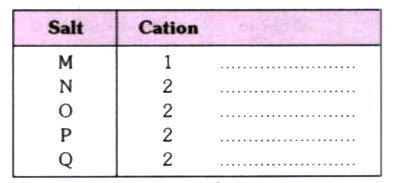When metal ‘M’ is treated with NaOH, a white gelatinous precipitate ‘X’ is obtained, which is soluble in excess of NaOH. Compound ‘X’ when heated strongly gives an oxide which is used in chromatography as an adsorbent. The metal ‘M’ is
Fe
Zn
Ca
Al
The correct Answer is:D
To solve the problem step by step, we can follow this reasoning:
Step 1: Identify the Reaction
When metal ‘M’ reacts with sodium hydroxide (NaOH), it produces a white gelatinous precipitate ‘X’. This indicates that metal ‘M’ is likely to be a metal that forms a hydroxide which is insoluble in water but soluble in excess NaOH.
Hint: Look for metals that form amphoteric hydroxides.
Step 2: Analyze the Precipitate
The white gelatinous precipitate ‘X’ is soluble in excess NaOH. This characteristic is typical of amphoteric hydroxides, which can dissolve in both acids and bases.
Hint: Recall that aluminum hydroxide (Al(OH)₃) is an amphoteric hydroxide.
Step 3: Consider the Heating of Precipitate
The problem states that when compound ‘X’ is heated strongly, it gives an oxide that is used as an adsorbent in chromatography. This suggests that the oxide formed from ‘X’ is significant in chromatography.
Hint: Think about common metal oxides used in chromatography.
Step 4: Identify the Metal
Given that aluminum hydroxide is a white gelatinous precipitate that is soluble in excess NaOH and that heating it produces aluminum oxide (Al₂O₃), which is indeed used as an adsorbent in chromatography, we can conclude that the metal ‘M’ is aluminum.
Hint: Remember that Al₂O₃ is commonly used in chromatography.
Step 5: Conclusion
Thus, the metal ‘M’ is aluminum.
Final Answer: The metal ‘M’ is aluminum.
---
When metal ‘M’ reacts with sodium hydroxide (NaOH), it produces a white gelatinous precipitate ‘X’. This indicates that metal ‘M’ is likely to be a metal that forms a hydroxide which is insoluble in water but soluble in excess NaOH.
The white gelatinous precipitate ‘X’ is soluble in excess NaOH. This characteristic is typical of amphoteric hydroxides, which can dissolve in both acids and bases.
The problem states that when compound ‘X’ is heated strongly, it gives an oxide that is used as an adsorbent in chromatography. This suggests that the oxide formed from ‘X’ is significant in chromatography.
Given that aluminum hydroxide is a white gelatinous precipitate that is soluble in excess NaOH and that heating it produces aluminum oxide (Al₂O₃), which is indeed used as an adsorbent in chromatography, we can conclude that the metal ‘M’ is aluminum.
Thus, the metal ‘M’ is aluminum.
Similar Questions
Knowledge Check
- Question 1 - Select One
A metal M reacts with sodium hydroxide to give a white precipitate X which is soluble in excess of NaOH to give Y. Compound X is soluble in HCI to form a compound Z. Identify M.X,Y and Z
M , X , Y, ZASi,SiO2,Na2siO3,SiCI4BAI,AiI(OH)3,NaMgO3,AICI3CMg,Mg(Oh)3,NaMgO3,MgCI2DCa,Ca(OH)2,Na2CO3,NaHCO3
When phenol is treated with bromine water, white precipitate is obtained. Give the structure and the name of the compound formed.
View SolutionWhen metal X is treated with sodium hydroxide, a white precipitate (A) is obtained, which is soluble in excess of NaOH to give soluble complex (B). Compound (A) is soluble in dilute HCl to form compound (C). The compound (A) when heated strongly gives (D), which is used to extract metal. Identify (X), (A), (B), (C) and (D). Write suitable equations to support their identities.
View SolutionZinc(II) ion on reaction with NaOH first give a white precipitate which dissolves in excess of NaOH due to the formation of :
View SolutionWhen a KI solution is added to a metal nitrate, a black precipitate is produced which dissolves in an excess of KI to give an organge solution. The metal ion is:
View SolutionIdentify the anion present in the following compounds:
i] Compound X on heating with copper turnings & conc. sulphuric acid liberates a reddish brown gas.
ii] When a solution of compound Y is treated with silver nitrate solution a white precipitate is obtained which is soluble in excess of ammonium hydroxide solution.
iii] Compound Z which on reacting with dilute sulphuric acid liberates a gas which turns lime water milky, but the gas has no effect on acidified potassium dichromate solution.
iv] Compound L on reacting with barium chloride solution gives a white precipitate insoluble in dilute hydrochloric acid or dilute nitric acid.View SolutionWhich of the following sulphides when heated strongly in air gives the corresponding metal?
View SolutionSalts M, N, O, P and Q undergo reactiom (i) to (v) respectively.
Identify the cation present in these salts on the basis of these reaction. Tabulate your answer in the format given below.
1. When sodium hydroxide solution is added to the salt M, and heated strongly a colourless gas with a pungent smell is evolved which turm red litmus paper blue and gives dense white fumes with a moist glass rod with hydrochloric acid.
2. Addition of dilute hydrochloric acid to a solution of N gives a thick white precipitate which is soluble in hot water.
3. When ammonium hydroxide solution is added to the solution of 0 a light blue precipitate is obtained which is soluble in excess of ammonium hydroxide to form an inteme deep blue solution.
4. When ammonium hydroxide solution is added to the solution of P reddish brown (mustard colour) precipitate is obtained which ,is insoluble even in the excess of ammonium hydroxide solution.
5. When sodium hydroxide solution is added to the solution of Q a which coloured gelatinous precipitate is obtained which is soluble in excess of sodium hydroxide to form a clear solution
 View Solution
View Solution
